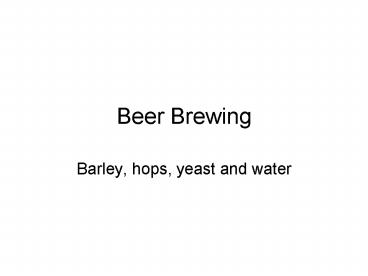Beer Brewing - PowerPoint PPT Presentation
1 / 17
Title:
Beer Brewing
Description:
Beer Brewing Barley, hops, yeast and water Overview Overview Inputs Barley Highest quality standards Low protein preferable American barley is high in protein Other ... – PowerPoint PPT presentation
Number of Views:734
Avg rating:3.0/5.0
Title: Beer Brewing
1
Beer Brewing
- Barley, hops, yeast and water
2
Overview
Inputs
Brewhouse
Outputs
Preprocessing
Grind
Barley
Malt
Water
Spent grain
Mash
Filter
Lauter
Hops
Trub
Process
Boil
Yeast
Ferment
Filter
Yeast
Cold condition
Finished beer
3
Overview
4
Inputs
- Barley
- Highest quality standards
- Low protein preferable
- American barley is high in protein
- Other grains can be used, such as wheat, oats,
rice, or corn but barley makes up the majority of
the grist
5
Inputs
- Water
- Hardness and alkalinity are important
- Low levels of contaminants, otherwise filtering
is necessary
6
Inputs
- Hops
- A herb, one of many that were traditionally used
in beer making - Can add bitterness, flavour or aroma, depending
on when it is added to the boil - Hop oils are concentrated in the flower
- Lots of different varieties from around the
world, each with its own subtle flavours
7
Inputs
- Yeast
- A single celled organism, it is responsible for
transforming sugar into alcohol and other flavour
compounds - Two main types used in beer making
- Ale
- Ferments only above 18C
- Has a strong influence on flavour
- Lager
- Ferments at any temperature above freezing
- Ferments clean (small influence on flavour)
- Many different strains from around the world
8
Preprocessing
- Malting
- Allow the barley seed to germinate
- Grow only enough to release the plants store of
enzymes - Kiln to kill the growing plant
- Polish to remove rootlet and shoot
- Roasting
- Different levels of roasting give different
flavours - Can be crystal or base malts depending on
technique
9
Preprocessing
- Water filtering
- Remove any unwanted contaminants
- Add salts to bring the profile into the range you
want - Soft water for light coloured beers
- Hard water for stouts
- Water chemistry is responsible for the unique
beers that were developed in different regions of
the world - Stouts require very hard water
- Pilseners require very soft water
10
Preprocessing
- Hops processing
- Hops are harvested, and processed at the farm, as
the flowers need to be dried to preserve them - Can be left as whole flowers, packed into plugs
or pelletised - Each has its advantages and disadvantages
11
Overview
12
Brewing
- First, the malt is ground so that water can get
inside - Crushed between rollers
- Then, it is soaked in water (mash)
- Water temperature is adjusted to activate
different enzymes. There can be multiple
temperature rests, or only a single rest to
convert starch to sugar - The liquid is then drained from the bottom of the
tun lautering
13
Brewing
- The sweet liquor is drained into the kettle,
where it is boiled - Hops are added at various times
- 60 minutes to go bitterness
- Bitter compounds are large and take time to
dissolve - 20 minutes to go flavour
- Flavour compounds are smaller, they take time to
dissolve but evaporate over time - 5 minutes to go aroma
- The smallest compounds, dissolve readily but also
evaporate extremely easily
14
Brewing
- The boiled wort is then drained from the
kettle, through a chiller which cools it to the
correct fermentation temperature - Yeast is added
- Primary fermentation normally takes a week, and
the yeast are consuming mainly the easy sugars - The beer is then transferred to a second vessel,
where the yeast start to consume the hard
compounds
15
Brewing
- Once fermentation is complete the beer can be
filtered - Large commercial breweries normally filter
- Some people dont like yeast
- Makes beer bright
- Can increase stability (shelf life)
- Smaller breweries often dont filter
- Beer will then age like wine
- Some like yeast flavour
16
Brewing
- The beer is then cooled for cold-conditioning
- If it is a lager, the yeast can continue
fermenting - For all types of beer, tannins and other
bad-tasting compounds drop out of solution,
improving flavour
17
Products
- Spent grain is normally fed to livestock
- Trub is the yeast, spent hops and other sediment
from fermentation - The yeast is often washed and reused
18
Overview































